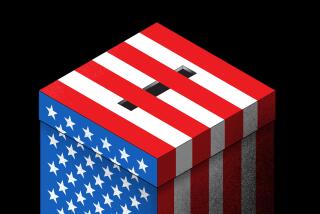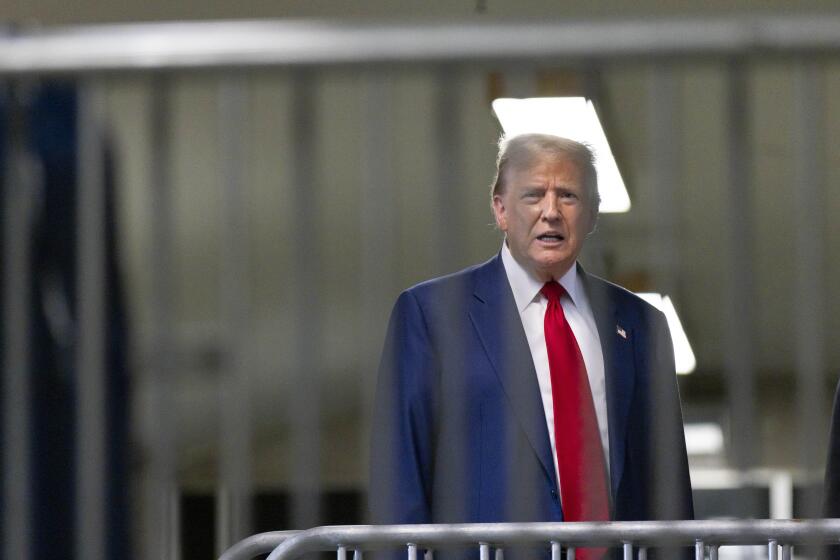Vacancy Rate on Federal Bench Is at a 13-Year Low
The vacancy rate on the federal bench is at its lowest point in 13 years, because of a recent surge of judges nominated by President Bush and confirmed by the Senate.
The intense partisan battle over a handful of judges aside, Bush has already won approval of 168 judges, more than President Reagan achieved in his first term in the White House. And with 68 of his nominees winning confirmation in 2003 as of Wednesday, President Bush has had a better record this year than President Clinton achieved in seven of his eight years in office.
Experts who track federal judgeships say Republican complaints about a Democratic filibuster of four judges have obscured the larger picture.
“The Bush administration has been spectacularly successful in getting the overwhelming proportion of its judicial nominations confirmed,” said political scientist Sheldon Goldman at the University of Massachusetts, Amherst. “There are only a relative handful being filibustered and held up. And this contrasts with the dozens of Clinton nominees who were held up by the Republicans in the last six years of the Clinton administration. The truth is the Republicans have had an outstanding record so far.”
The Republican-controlled Senate Judiciary Committee lists 39 vacancies among the 859 seats on the U.S. district courts and the U.S. courts of appeal -- a 4.5% vacancy rate.
This is the fewest number of vacancies since 1990. During Clinton’s term in office, the number of vacancies on the federal bench was never fewer than 50, according to the Administrative Office of the U.S. Courts.
Today, the Senate committee is set to vote on four more judicial nominees, including California Supreme Court Justice Janice Rogers Brown. She is likely to be opposed by almost all of the panel’s Democrats, one of whom called her a “right-wing judicial activist” during a hearing two weeks ago.
If confirmed by the full Senate, Brown would fill a seat on the U.S. Court Of Appeals in the District of Columbia that is vacant in part because Republicans blocked two candidates that Clinton nominated in 1999.
Washington lawyer Allen Snyder, a former clerk to U.S. Supreme Court Chief Justice William H. Rehnquist, had a hearing in the committee, but despite a lack of opposition, he failed to gain a confirmation vote in the Senate. White House lawyer Elena Kagan was denied even a hearing in the GOP-controlled Judiciary Committee. She has since become dean of Harvard Law School.
Upon taking office, President Bush named Washington lawyers John Roberts and Miguel A. Estrada to the same appeals court. Roberts, also a former clerk to Rehnquist, won confirmation this year and is now the junior judge on the U.S. Court of Appeals for the District of Columbia. Democrats filibustered and blocked a final vote on Estrada, who subsequently withdrew.
In July, President Bush chose Brown to fill the vacancy.
Even if she wins a narrow approval today, the minority Democrats may block her from a final vote in the Senate. Besides Estrada, they have blocked votes on Mississippi Judge Charles W. Pickering Sr., Texas Supreme Court Justice Priscilla R. Owen and Alabama Atty. Gen. William H. Pryor Jr. Also waiting a final confirmation vote is Los Angeles Superior Court Judge Carolyn B. Kuhl, Bush’s nominee to the U.S. 9th Circuit Court of Appeals.
Administration officials concede that most of Bush’s judges are being approved, but they point to the blocking of the appeals court nominees as extraordinary.
The vacancy rate “has been getting lower, but the real problem is the showdown at the circuit courts. We have seen an unprecedented obstruction campaign against the president’s nominees for the circuit courts,” said John Nowacki, a Justice Department spokesman. The department’s Web site says there are 41 vacancies on the federal bench, if the U.S. Court of Claims and the International Trade Court are included in the total.
The administration says Bush has made 46 nominations to the appeals court, but only 29 have won confirmation. “That’s a 63% confirmation rate. Clinton had an 80% confirmation rate at the same time,” Nowacki said. “There is something different going on here. It’s an obstruction at entirely different level.”
Goldman, the University of Massachusetts professor, said both parties have blocked prospective judges they viewed as extreme, but they have done it in different ways.
“The Republicans obstructed quietly in the committee,” Goldman said. “If they didn’t want to approve you, you just didn’t get a hearing. The Democrats have obstructed through the use of the filibuster, which is very open and visible.”
During Clinton’s final six years in office, Republicans controlled the Senate, and they refused to confirm more than 60 of his judicial nominees.
*
(BEGIN TEXT OF INFOBOX)
Bench strength
Here’s how President Bush’s confirmed nominations to federal judgeships compares with his three predecessors:
President George W. Bush
2003: 68
2002: 72
2001: 28**
President Bill Clinton
2000: 40*
1999: 33*
1998: 65*
1997: 36*
1996: 20*
1995: 55*
1994: 101
1993: 28
1992: 66*
President George H. W. Bush
1991: 56*
1990: 55*
1989: 15*
President Ronald Reagan
1988: 41*
1987: 43*
1986: 44
1985: 84
1984: 43
1983: 32
1982: 47
1981: 41
* Senate controlled by opposition
** Senate evenly divided until Sen. James M. Jeffords of Vermont left the Republican Party to become an independent
Sources: Administrative Office of the U.S. Courts
More to Read
Get the L.A. Times Politics newsletter
Deeply reported insights into legislation, politics and policy from Sacramento, Washington and beyond. In your inbox three times per week.
You may occasionally receive promotional content from the Los Angeles Times.







